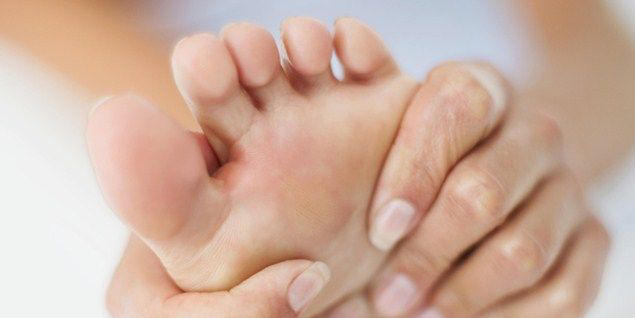What to do when plantar fasciitis is so bad you can't walk
![]()
![]()
![]()
![]()
What to do when plantar fasciitis is so bad you can't walk
Managing pain in the foot can be extremely challenging, particularly when conditions like plantar fasciitis prevent you from walking. Unfortunately, it's one of the most common running injuries and can take months to dissipate.
- Plantar fasciitis is especially prevalent in women aged 40 to 60. Those who are overweight have a much higher risk of developing the injury, too, as more load is placed through the foot.
Often associated with repetitive strain and overuse, the condition can flair up when runners overload their training or do too much, too soon. But like with most running-related injuries, the causes are multi-faceted and can be due to biomechanics, footwear and even the shape of your foot.
- How do I know if I have plantar fasciitis?
Sports scientists have been unable to exactly pinpoint whether plantar fasciitis is an inflammatory condition or a degenerative one, but one thing is known: it can be extremely painful. The pain is caused by discomfort of the plantar fascia tissue that spans the underside of the foot, linking the heel bone to the toes. Everything you need to know about what the condition is can be found in our explainer.
- Can plantar fasciitis become so bad you are unable to walk?
- The severity of pain varies widely between different individuals but for some it can lead to a lot of discomfort while walking. At its worst, symptoms typically include a sharp or stabbing pain in the heel or arch of the foot.'
You can often feel a sudden pain when you get up in the morning or if you've been resting for a while,' explains oot health specialist Bente Smith-Rewse, founder of Enertor. 'The pain can get better if you're doing exercises but then it will return after you have rested.'
- When the condition progresses further it can make walking very painful, and trying to walk can actually aggravate, rather than elevate, the symptoms. In some extreme cases, patients can undergo an operation to decrease the stress on the plantar fascia.
- How can you manage plantar fasciitis when you are unable to walk?
- There are a number of steps that can be taken to help your feet recover without putting too much load through them. But the earlier you can address the symptoms the better. Check out this comprehensive guide on preventative exercises that will help stop plantar fasciitis from returning in the long term.
If walking is painful, taking a series of short term measures will help you to manage the pain before you can move onto foot strengthening exercises.
- Stop the activity: First and foremost, stop the activity that is causing the problem. If walking is painful then try to ease back on the amount you do until the pain subsides.
- Pain relief: In the short term, pain relief such as paracetamol or ibuprofen can help to ease symptoms along with icing the sore area. In more extreme cases, a physio may recommend a cortisone injection to ease pain and swelling. This can work in the affected area for up to six months, allowing you to rehabilitate your plantar fascia more effectively. The injection will not cure plantar fasciitis, it will simply mask the pain.
-
- Footwear: Ensuring you have supportive footwear is key to getting you walking without pain again. 'Improve the footwear so that you have support in the arches,' says Smith-Rewse. 'Don't wear anything with a heel or without support. Get really good insoles inside that footwear and it will do wonders.'
- Taping and splints: Taping the foot can help to alleviate pressure, as can a splint or brace for supporting and stretching the arch. However, these should only be used following advice from a medical professional. 'Tape, provided it's done correctly, often works extremely well,' says Smith-Rewse. 'It does mean you have to learn how to do it and be shown by a physio. But tape stabilises the foot so there's slightly less movement.'
- Cross training: If you are unable to walk but want to keep moving, cross training is a fantastic way to stay fit. Ensure it is an activity that doesn't cause pain. Swimming, which is non-weight bearing, can be a great alternative. Take a look at our guide to cross training while injured or our round-up of the best cross trainers for your home.
- Stretching: Simple exercises like rolling a ball or bottle under your foot will help to stretch and roll the plantar fascia tissue. In the beginning, this can help to ease any pain and in the longer term you can build in more foot-specific strength exercises to prevent the condition from returning.
- Shock wave therapy: This is a temporary measure but combined with an insole it can help to reduce recovery time and get you walking sooner. Speak to a physiotherapist to see if this is an appropriate option for your condition and will help to reduce pain.
What can make plantar fasciitis more painful?
- Exercise: Doing the activity that caused the injury is highly likely to increase the pain. Ease off any aggravating exercise and cross train instead.
- High heels: 'Whatever you do, don't wear high heels,' says Smith-Rewse. 'If you have plantar fasciitis, high heels will make it worse.' Squeezing your feet into heels will force more pressure onto your foot, increasing the pain in the tissue band.
- Weight: Weight gain can increase the likelihood of pain because there is more load going through the feet. Plantar fasciitis is more common with people who are overweight so maintaining a healthy weight will help with symptoms.
- Bare feet: 'If you are in pain and then walking barefoot, that is an absolute no, no,' says Smith-Rewse. 'You have to wear footwear to control movement and to give your arch support.' This is particularly the case if you are walking on hard surfaces like stone floors which will worsen the irritation.
Should you seek medical help if you have plantar fasciitis so bad you are unable to walk?
- It is important to seek medical help early on to prevent the condition from worsening and to obtain an accurate diagnosis. A physiotherapist may be able to help stretch the fascia without causing further damage and recommend targeted exercises. In the first instance, get an appointment with your GP. If you are unable to walk then seeking medical advice is a must.
Articles - Latest
- 10 physio-approved exercises for runners that will help you build strength and mobility
- Forget sit-ups — this 3-move standing ab workout chisels your abs and obliques
- What to do when plantar fasciitis is so bad you can't walk
- Five exercises better than side bends to sculpt strong obliques
- Forget Russian Twists — this 10-minute stability ball workout targets your abs and glutes
- Professor explains how we are all doing one exercise wrong and it is causing us pain
- Supplies, Description, and Usage - Tech Nails-2
- Supplies, Description, and Usage - Tech Nails
- Exercises for Plantar Fasciitis
- Shoes, insoles and splints: Cushioning and support - Plantar fasciitis
- 10 best bum workouts and 25 bum exercises for a 🍑'ier butt
- The dos and don’ts of running when you’re over 40
- This 30-minute workout can be done from just about anywhere
- I teach stretching routines for a living — 3 exercises that strengthen your hips and open your hamstrings
- Somatic exercise has gone viral promising to lower cortisol levels, ease stress, and boost health - so, does it actually work?
- Planks and wall sits best exercise for lowering blood pressure, study says
- Four moves and six minutes is all you need to develop strength with this no-equipment routine
- I did a two-minute Farmer’s Carry every day for a week — here’s what happened
- No squats or lunges: This knee-friendly workout sculpts your lower body in 7 exercises
- Two dumbbells and five moves are all you need to build strength in the shoulders and back
- Add Muscle, Build Stamina and Fire up Your Metabolism with Our Three-Move Strongman Circuit
- How to clean running trainers without ruining them: 3 easy steps to take
- Podiatrist shares pain-inducing mistakes we're making when wearing high heels
- 9 things you need to know before getting acrylic nails
- Running could be just as effective at treating depression as medication, scientists find
Articles-Popular
- Home
- Calluses and Corns-4-Padding and Insoles To relieve Pressure
- Contacts
- Appreciate Your Feet
- WEB - LINKS
- Therapy Price List- Aromatherapy - Counselling
- The Awareness of Foot Care
- Nail Technician Resume
- Join us as a Therapist
- Gallery - Pedicured Feet
- Podiatry/Chiropody Price List
- Skin Care-Feet
- TCM - Therapy Prices
- Blisters on the Feet
- Nail Technician Job Description
- Galleries
- Bacterial Infections
- Itching Skin on the Feet
- Athlete's Foot
- Sweaty or Smelly Feet
- Appointments
- Skin Changes Associated with Blood Flow
- Common Toenail Conditions - Changes in Nail Colour
- Calluses and Corns - 2
- Insoles






